Styles of Saddles
•Stock Saddle
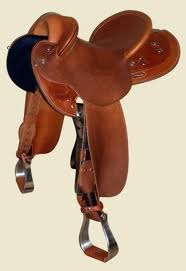 For styles of saddles, the stock saddle seat is appropriate for ranchers but is also used at rodeos and by many pleasure and trail riders. The saddle, which can weigh as much as 40 pounds (18 kilograms), is designed for rounding up cattle and is distinguished by a high pommel horn for tying a lariat. The rider employs long stirrups and a severe bit that he seldom uses because he rides with a loose rein, guiding his horse chiefly by means of shifting the weight of his body in the saddle.
For styles of saddles, the stock saddle seat is appropriate for ranchers but is also used at rodeos and by many pleasure and trail riders. The saddle, which can weigh as much as 40 pounds (18 kilograms), is designed for rounding up cattle and is distinguished by a high pommel horn for tying a lariat. The rider employs long stirrups and a severe bit that he seldom uses because he rides with a loose rein, guiding his horse chiefly by means of shifting the weight of his body in the saddle.
•Roping
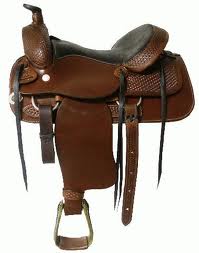 The quality roping saddle has a deep seat and the fenders hung in a position, ensuring the rider can be upright and well-balanced when ready to rope. The horns and trees are extra strong to take the pull. The rigging on the roper saddle must be one that pulls off the top of the tree bars and has great strength. Generally suede out padded seats are preferred to give more grip. The swells of the saddle are kept reasonably low as to keep the leverage of the rope on the horn to a minimum.
The quality roping saddle has a deep seat and the fenders hung in a position, ensuring the rider can be upright and well-balanced when ready to rope. The horns and trees are extra strong to take the pull. The rigging on the roper saddle must be one that pulls off the top of the tree bars and has great strength. Generally suede out padded seats are preferred to give more grip. The swells of the saddle are kept reasonably low as to keep the leverage of the rope on the horn to a minimum.
•Cutting
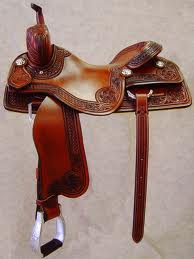 Other styles of saddles include the cutting saddle which is used with cutting horses and cutting. Cutting is the activity of removing a cow from the herd, which might be done in an actual work situation or in a competition. During cutting, the horse makes sudden stops, lunges, and hairpin turns, so the rider needs a saddle to help him stay in the seat. These Western styles of saddles have very high swells for this purpose, along with a high horn that’s usually relatively small in diameter. The saddle seat has a low rise that helps the rider stay balanced and centered, along with narrow stirrups.
Other styles of saddles include the cutting saddle which is used with cutting horses and cutting. Cutting is the activity of removing a cow from the herd, which might be done in an actual work situation or in a competition. During cutting, the horse makes sudden stops, lunges, and hairpin turns, so the rider needs a saddle to help him stay in the seat. These Western styles of saddles have very high swells for this purpose, along with a high horn that’s usually relatively small in diameter. The saddle seat has a low rise that helps the rider stay balanced and centered, along with narrow stirrups.
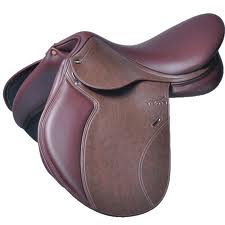 •All Purpose Considered an english style of saddle the General Purpose / All Purpose Saddles are widely used and very versatile. The cut of the saddle flaps and the height of the pommel and cantle allow for use in dressage, cross country and show jumping.
•All Purpose Considered an english style of saddle the General Purpose / All Purpose Saddles are widely used and very versatile. The cut of the saddle flaps and the height of the pommel and cantle allow for use in dressage, cross country and show jumping.
•Hunt-Jump
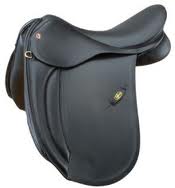 Jumping Saddles aim to give the rider extra grip and closeness. The saddle flaps and knee rolls are positioned further forward to accommodate for the more acute knee angle of the rider, providing better grip at the knee. The pommel and cantle are not raised high, enabling the rider to move in and out of jumping positions easily and without restriction.
Jumping Saddles aim to give the rider extra grip and closeness. The saddle flaps and knee rolls are positioned further forward to accommodate for the more acute knee angle of the rider, providing better grip at the knee. The pommel and cantle are not raised high, enabling the rider to move in and out of jumping positions easily and without restriction.
•Polo
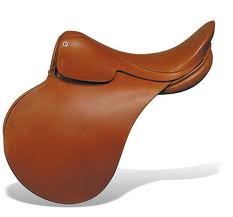 The polo saddle is designed specifically for the mounted game. It has a relatively flat seat and the saddle flaps are long and fairly straight to accommodate the longer leg position, although more forward than the dressage saddle.
One of the defining features of the polo saddle is that there is very little or no padding under the leg, allowing the rider to have maximum freedom of movement. If the saddle had thigh or calf blocks, the leg would not be allowed to swing forward or back as needed
The polo saddle is designed specifically for the mounted game. It has a relatively flat seat and the saddle flaps are long and fairly straight to accommodate the longer leg position, although more forward than the dressage saddle.
One of the defining features of the polo saddle is that there is very little or no padding under the leg, allowing the rider to have maximum freedom of movement. If the saddle had thigh or calf blocks, the leg would not be allowed to swing forward or back as needed
•Dressage
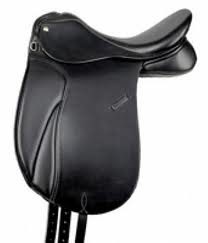 Dressage Saddles offer a closer fit to the horse, maximising contact between horse and rider. Knee rolls and saddle flap length are often longer, helping to create a longer, more effective leg position. The pommel and cantle are often a little higher giving non restrictive security and support when in the seat and excellent centre of balance for the rider.
Dressage Saddles offer a closer fit to the horse, maximising contact between horse and rider. Knee rolls and saddle flap length are often longer, helping to create a longer, more effective leg position. The pommel and cantle are often a little higher giving non restrictive security and support when in the seat and excellent centre of balance for the rider.
•Racing
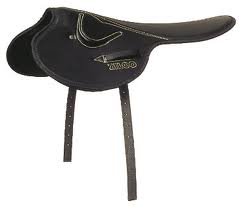 The race saddle has only one girth strap on each side, compared to a regular English saddle that has two or three. An 'over girth' would be strapped over the seat of the saddle so that it is very secure. The total width of the saddle from the bottom of each flap and across the seat is 20 inches. They are very tiny and lightweight. The jockey does not sit in the saddle, but stays perched over the horse's shoulders. You might come across a saddle like this at a flea market or auction sale. These Styles of saddles are not suitable for general riding.
The race saddle has only one girth strap on each side, compared to a regular English saddle that has two or three. An 'over girth' would be strapped over the seat of the saddle so that it is very secure. The total width of the saddle from the bottom of each flap and across the seat is 20 inches. They are very tiny and lightweight. The jockey does not sit in the saddle, but stays perched over the horse's shoulders. You might come across a saddle like this at a flea market or auction sale. These Styles of saddles are not suitable for general riding.
•Side saddles
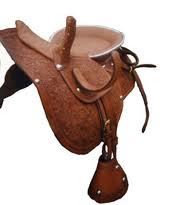 Although sidesaddles are still manufactured today, it is a small niche market compared to other styles of saddles, and a new model is quite expensive. Thus, many riders who wish to ride sidesaddle are often found hunting for older saddles at antique shops, estate sales, and in dusty attics or barn lofts. It is difficult to find an antique sidesaddle that not only fits the rider and horse but also is in good condition. Old sidesaddles usually need reconditioning, sometimes even requiring complete removal of the leather and examination of the tree (the wooden understructure of a saddle). The saddle must be fitted to the horse, and ideally, such fitting is done by a specialist experienced in sidesaddle construction. Antique sidesaddles are frequently a problem to fit, as many are too narrow for modern horses
Although sidesaddles are still manufactured today, it is a small niche market compared to other styles of saddles, and a new model is quite expensive. Thus, many riders who wish to ride sidesaddle are often found hunting for older saddles at antique shops, estate sales, and in dusty attics or barn lofts. It is difficult to find an antique sidesaddle that not only fits the rider and horse but also is in good condition. Old sidesaddles usually need reconditioning, sometimes even requiring complete removal of the leather and examination of the tree (the wooden understructure of a saddle). The saddle must be fitted to the horse, and ideally, such fitting is done by a specialist experienced in sidesaddle construction. Antique sidesaddles are frequently a problem to fit, as many are too narrow for modern horses
•Endurance
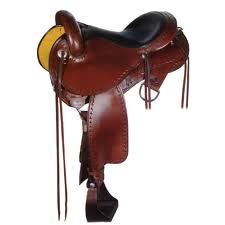 The Endurance saddle is used for the long-distance competition of endurance riding. Its major task is to provide the horse and rider with the comfort and balance needed to cover long distances over rough terrain, sometimes for multiple days. For the rider, the seat is often quilted or padded, and the stirrups are designed with a wide foot tread to reduce fatigue. For the horse, the panels skirts of the saddle are extended to provide a larger area of contact with the back, thus reducing fatigue linked to the pounds per square inch of saddle contact. The saddle has many dee rings along the pommel and cantle that allow the rider to attach various items.
The Endurance saddle is used for the long-distance competition of endurance riding. Its major task is to provide the horse and rider with the comfort and balance needed to cover long distances over rough terrain, sometimes for multiple days. For the rider, the seat is often quilted or padded, and the stirrups are designed with a wide foot tread to reduce fatigue. For the horse, the panels skirts of the saddle are extended to provide a larger area of contact with the back, thus reducing fatigue linked to the pounds per square inch of saddle contact. The saddle has many dee rings along the pommel and cantle that allow the rider to attach various items.
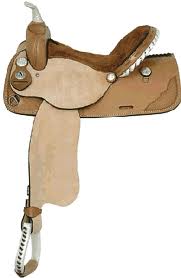
•Barrel Racing These Western Styles of saddles are specifically designed for barrel racing, which involves sharp turns and high speeds. As a result, the rider needs a saddle that helps her remain seated, so the barrel saddle has a deep seat with a high fork and a high cantle. The seat itself is usually covered in suede. Suede isn’t as slick as leather, so it helps prevent the rider from sliding in the seat. A typical barrel racing saddle also has a tall, narrow horn that’s easy for the rider to grip. Barrel racing saddles are often lightweight so that they won’t slow the horse down.
Source - Charli Love, Styles of saddles